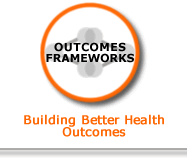
Driver Diagrams
What are they?
When can they be used?
How do you use them?
What is the difference between them?
Links
Driver diagrams and logic models are tools to help planning. They both provide a “theory of change”.
| Driver diagrams are a type of structured logic chart with three or more levels. Driver diagrams include:
|
Logic models are a type of structured diagram which connects Outcomes with Activities and specifies Reach (or target groups) for those activities. |
|
When can they be used?
Both logic models and driver diagrams can:
- help a group to explore the factors that they believe need to
- be addressed in order to achieve a specific overall goal or result.
- show how the factors are connected
- act as a communication tool to explain a change strategy
- provide the basis for a measurement framework
Driver diagrams - The steps in the process of creating a driver diagram are:
1. Gather together a group of experts on the subject matter
2. Brainstorm to identify the things which need to be improved to achieve the goal (presumably the goal has been specified previously)
3. Cluster the ideas to see if groups represent a common driver
4. Expand the groups (or single ideas) to see if new drivers come to mind
5. Logically link together the groups into a driver diagram format
6. Work backwards from project ideas if that helps
Logic models - The steps in the process of creating a logic model are:
1. Set up a group of experts
2. Identify outcomes based on the available evidence
3. Group outcomes into common themes
4. Refer to the relevant outcomes framework to ensure all appropriate outcomes have been considered, including unintended outcomes
5. Put outcomes in a hierarchy
6. Identify reach (or target group) and activities which will achieve the outcomes. Including reach will help you consider inequality issues.
7. Identify ways to measure outcomes and reflect on draft model.
What is the difference between them?
Driver diagrams work back from the project, whereas logic models work back from the outcome. Consequently, logic models may be better at helping planners prioritise based on outcomes
Logic models which have been created by NHS Health Scotland are underpinned by evidence, driver diagrams are informed by expert opinion.
Logic models include “Reach” and are useful in identifying inequalities issues which should be considered when planning effective activities which will achieve desired outcomes
There is evidence that using logic models improves planning, we have not identified any evidence that using driver diagrams improves planning.
Links to more information on driver diagrams and logic models
Driver diagrams:
NHS Institute for Innovation and Improvement
NHS Scotland Quality Improvement Hub
examples
Logic models:
Theory of Change Logic model for local level

